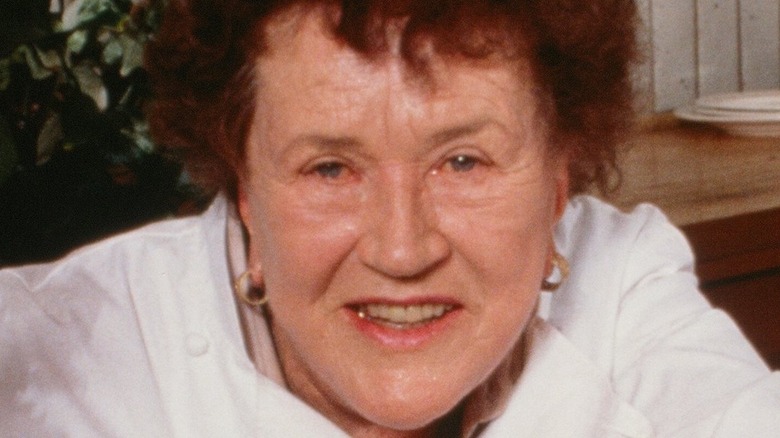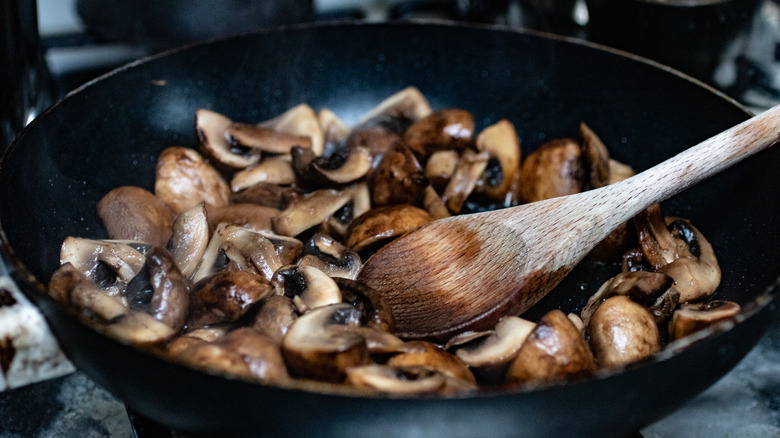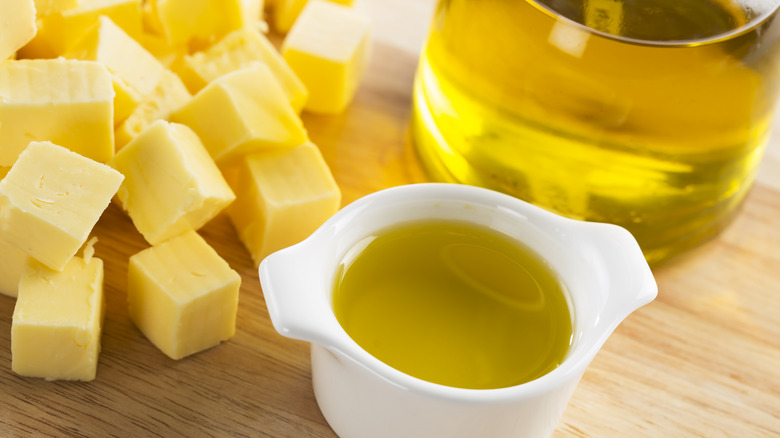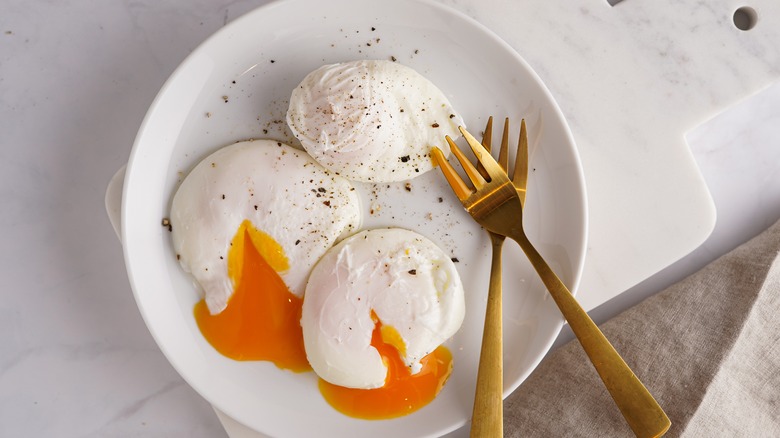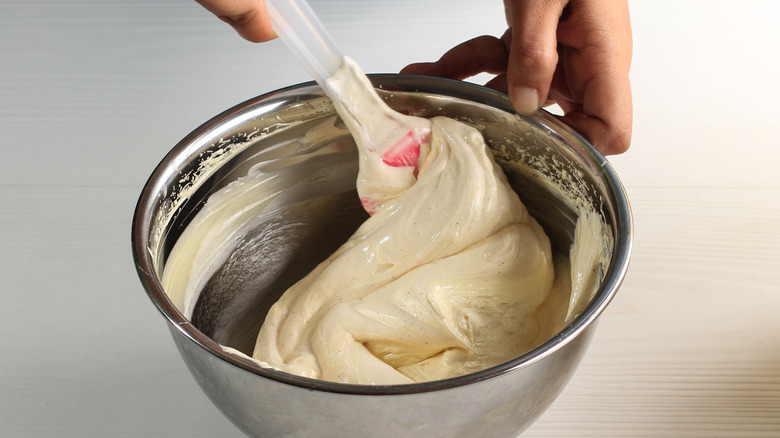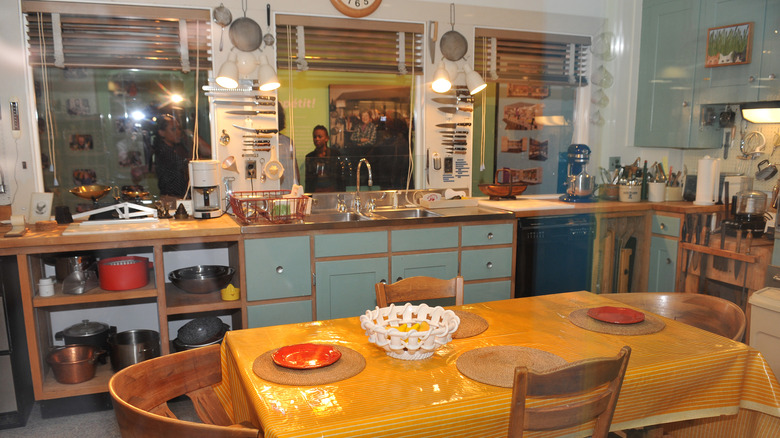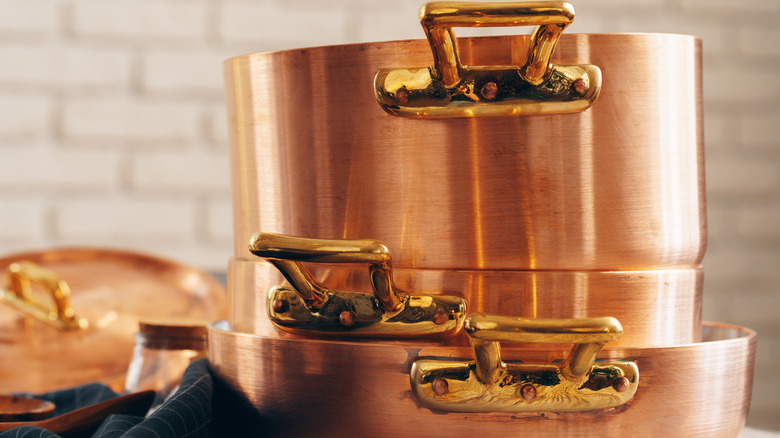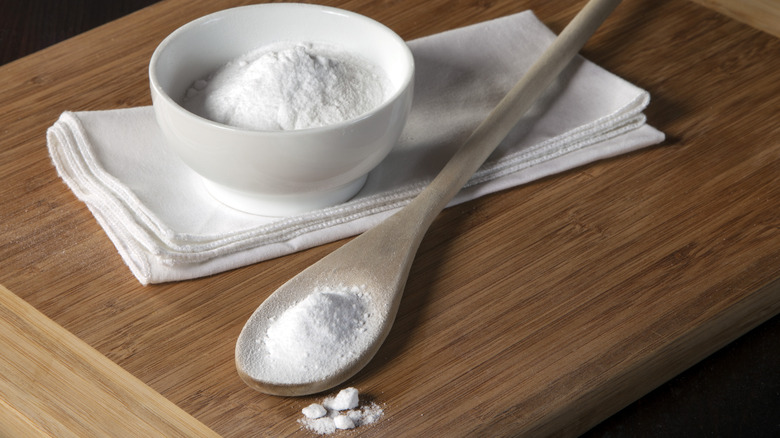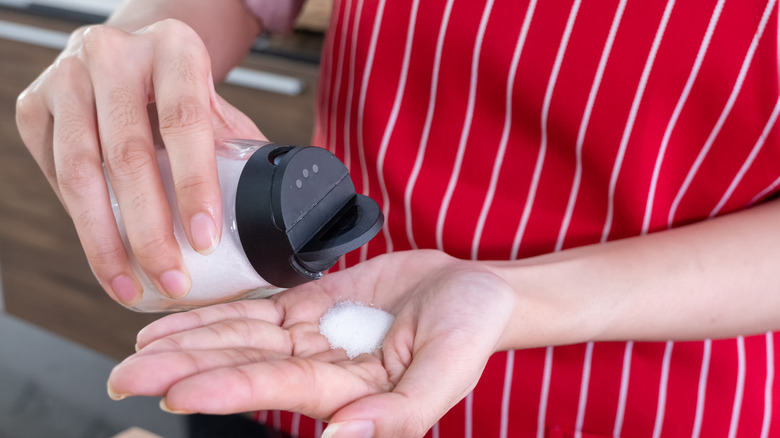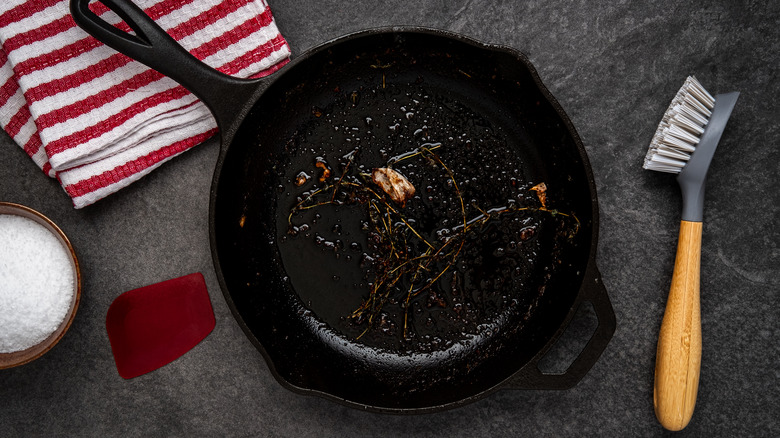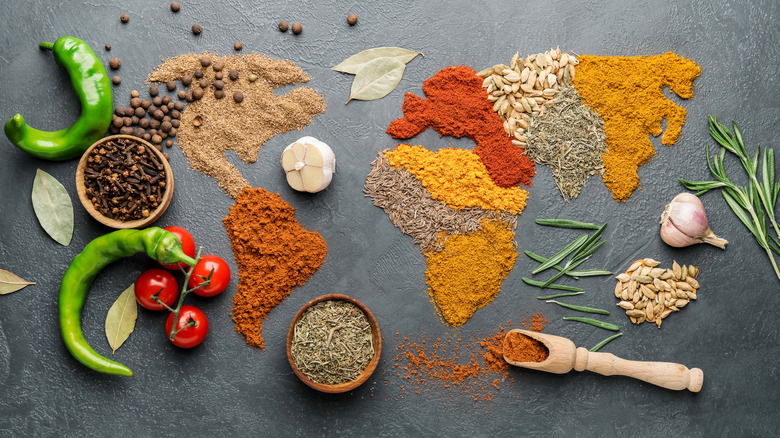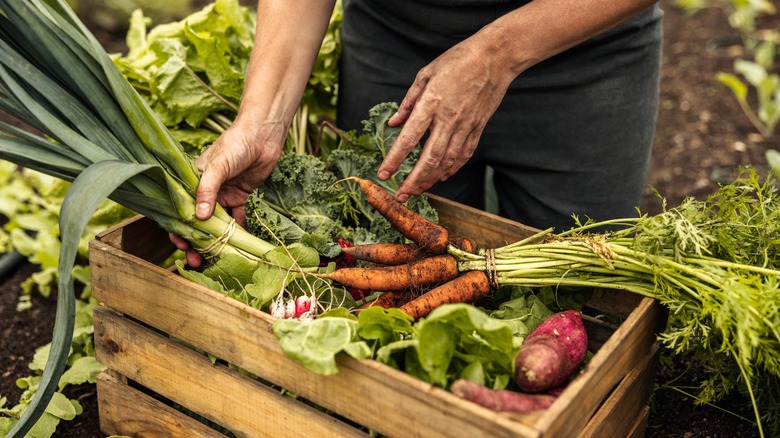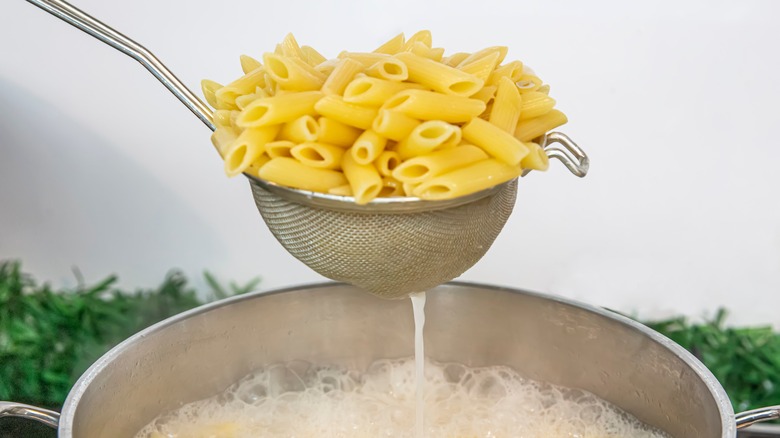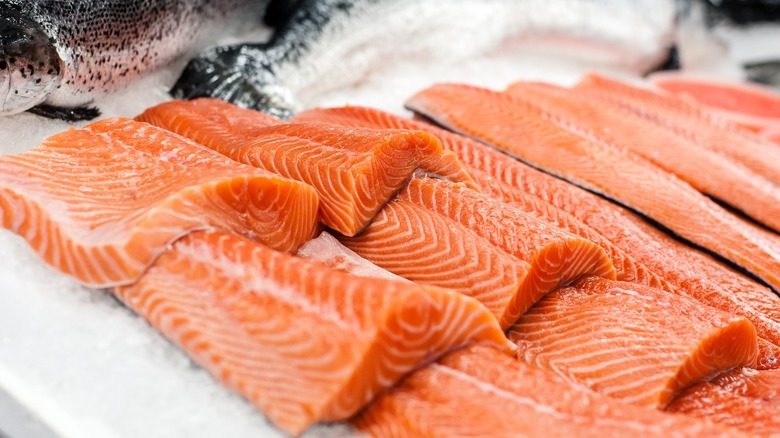Julia Child's 14 Best Cooking Tips For Home Chefs
We may receive a commission on purchases made from links.
Much has been written about the legendary chef and TV icon Julia Child. She is credited for bringing traditional French cuisine into the homes and hearts of Americans by showcasing techniques in a simple and accessible way.
More than just a good teacher, Child was known for her sense of humor, her authentic and imperfect delivery, and her relentless drive to break down barriers and uplift the value of women in the kitchen. Her refusal to quit culinary school despite being the only woman admitted to Le Cordon Bleu in France, in 1949, is proof of said drive and stubborn determination (via Showbiz CheatSheet).
In an era that touted the perfect happy housewife as the standard for all women, Child added a sense of depth, fallibility, humanity, and bravery in the kitchen, as well as timeless advice. Here are some of Julia Child's best tips and nuggets of wisdom, applicable to home (and professional) cooks everywhere.
Don't overcrowd your pan
So much of cooking revolves around patience. Paradoxically, of course, we often come into the kitchen already driven by feelings of hunger and the desire to alleviate them quickly. We want to make as much as we can as quickly as possible.
When it comes to pan cooking, however, sautéing or frying in small batches to avoid overcrowding will work in your favor to save you time and produce a delicious result. In fact, this was Julia Child's secret to achieving the best crispy-edged sautéed mushrooms. Ingredients that are water-rich, like mushrooms, will release their moisture when heated. In order to avoid steaming them — which is a different technique altogether — heed Julia's advice and spread them out in the pan to avoid using the water during their time in the pan.
Julia even suggests using as little water as possible, perhaps even just rubbing the mushrooms and trimming the stems to help remove dirt, to prevent further water absorption, which will only increase the need to really spread them out when they hit the pan (via Julia Child on PBS).
Sautée with oil and butter to prevent burning
Let this list inspire you to re-watch Julia Child in the kitchen, in search of all the nuggets of wisdom tucked into every show she filmed. As we know, Julia was perhaps butter's biggest fan, using well over 700 pounds of it during her series "Baking with Julia" (via PBS). Butter, like cream, is prevalent within French cuisine, which may have inspired her well-known saying, "If you are afraid of butter, use cream."
Despite its high-frequency use in her baking series, butter was used to enhance a variety of different flavors and cooking techniques throughout Child's repertoire. One of her best tips might just be this one, from her series "The Way to Cook Poultry". Here, she shows the audience that the best way to prevent butter from burning when using it to sautée is to simply add a splash of good olive oil or other high smoke point oils along with it. Given butter's low smoke point, it is not great for high-heat cooking unless protected, as Child suggests, with a flavorless oil with a higher smoke point.
Prick your eggs before poaching
One of the best things about dining out for brunch is the opportunity to order and eat poached eggs, as they can sometimes be a daunting cooking technique to perfect at home. There are so many different suggestions and poaching hacks out there that gadgets like egg poaching cups or egg poachers just aren't necessary. What is required, however, is a bit of time and the willingness to break a few eggs before you get it right.
While there are many different techniques from using vinegar to turning off the heat and covering the pot, Child's is a bit more outside the box — or, rather, inside the eggshell. Grab sewing needles or pins, because you'll need them.
Rather than worrying about wispy, runaway egg whites, Child instructs home cooks to make perfect poached eggs by first poking each egg once with a pin or needle to release any air inside, all while keeping the egg whole and in its shell. Then, lower the egg into a pot of boiling water for a total of 10 seconds, after which you can crack open the egg and poach as you normally would, using any preferred method. If Julia says to do it, there must be something to it.
Fold from the center, outwards
Folding is not just for laundry or paper. In cooking, it's a way to mix ingredients while keeping a light and airy quality to the batter. It's a technique used in many foods we love, from fluffy cheese soufflé to mousse to meringues, and is a necessary skill to learn when it comes to learning to cook French cuisine well. It comes as no surprise then, that Julia Child gave her readers and viewers some good advice on how to fold.
Child explains it quite simply: To fold best, stick your spoon or, ideally, rubber spatula straight down into the very center of the bowl. Then, following the curvature of the sloped sides, sweep your cooking utensil along the side of the bowl until you reach the top lip, lightly folding it over the top of your mixture. Then, begin again, moving in a different direction. This will help to keep those hard-earned air pockets in the batter and ensure a fluffy finish.
Hang your knives horizontally
When it comes to great cooking, one of the best pieces of advice there is, is to make sure you are well organized with ingredients, equipment, and a clear and clean space before the first ingredient ever hits the pan. It is why the French technique of mise en place — meaning "put in place" — exists and is emphasized especially in a professional kitchen.
One look at Child's kitchen, now an exhibit at the National Museum of American History and we can see how seriously she took this practice. Here we can also see Child's preferred method for storing her knives — horizontally on the wall.
When it comes to risks in the kitchen, a dull knife is often times more dangerous than a sharp one. The reason why is that it requires more force to perform tasks, making any slip-up that much more serious. Knives stored together in a drawer are not only dangerous when reaching for one, but the process of rubbing together dulls the knives, making them all the more dangerous when used as well.
Magnetic knife strips are a wonderful tool for organizing knives and keeping them from taking up valuable work surfaces, which are high-value commodities in many home kitchens. However, Child chose not to hang her knife strips vertically, positioning her knives horizontally to allow for ease when reaching for whichever knife she needed (and perhaps accounting for her own personal aesthetic preferences, too).
Cook with copper whenever possible
When it really boils down to it, most cooking is largely about heat control and having a basic understanding of the chemistry that takes place as a result. Once you understand and can put into practice the hard and fast science behind it, there becomes a great opportunity to add flourish, art, and inspiration on top.
Cooking techniques like searing, flambéing, high heat sautéing, and blanching are quick and require instant action from both the cook and equipment in order to achieve success. It is why Child preferred to use copper pots and pans most of the time (though she demonstrated with non-stick pans as well during her shows). Copper is an excellent heat conductor, meaning it reacts to direct and indirect heat in a matter of seconds, and holds onto it well so it can distribute it to cook your food (via Markham Metals).
Copper not only means faster and more efficient cooking, but it also puts more control into the hands of the cook, which is why Child preferred it to other materials. She did advise readers to look for high-quality copper products, rather than just the shiniest. Though, copper does get a few bonus points for being pretty enough to display in the kitchen, especially if you're short on storage.
Test your baking powder before using it
Much of cooking, as Julia Child is famous for showcasing, is a bit of an experiment, with both failures and successes as essential parts of the learning process. This includes what many of us only learn through experience, the shelf life of some of our standard pantry items. It's likely that if you make bread, you've had a loaf fail to rise due to old and inactive yeast. It turns out it's not just yeast but other rising agents like baking soda and powder also have a life expectancy.
According to the United States Department of Agriculture, sealed boxes of baking soda can be stored in ambient temperatures for up to 18 months, but need to be used within 6 months once opened. David Lebovitz gives baking powder around the same lifespan, though notably suggests baking soda can hang around for much longer.
So, how do you know if it's good or if it's going to ruin your next batch of chocolate chip cookies? Child suggests testing your baking powder by mixing one teaspoon of the leavening agent with half a cup of hot water. If it bubbles, you're in business. If not, you know it's time to get rid of it and buy fresh before using.
Salt your sauce at the end
Julia Child was a wonderful cook whose approach changed the ways in which recipes were written. She was also an incredibly thorough researcher, an engaged student, and a lifelong learner. During one such project entitled "Cooking with Master Chefs," — both a PBS aired show and a cookbook — Child sought out the advice and expertise of 16 professional and acclaimed chefs, from Alice Waters to Emeril Lagasse, for advice and recipes for the home cook. Child was interested in closing the gap between restaurant food and the homecooked meal.
It was during this project she devoted a section to sauces, noting the profound flavor distinctions between the average restaurant quality sauce and one made in the domestic kitchen. One key tip to increase flavor concentration is to reduce the sauce's volume, a process done over heat to thicken and intensify its flavors. A second key tip, says Child, is to wait until after it is reduced before salting and seasoning, tasting it first so you know how much is needed for balance (via PBS).
Season your pan for omelette success
Arguably one of the most brazen things Julia Child did was beginning her television career by cooking something perceived as simple — an omelette. Not just any omelette, of course, a French omelette. It took about 30 seconds or so to make, which allowed her to show it several times over using several pieces of equipment. Despite many naysayers behind the screens, it launched her career, helped a huge number of home cooks, and has since become the muse for other Julia-inspired television (via Vulture).
In this 30-minute segment of "The French Chef Season 1," there is a lot of good information and tips to take away. Child shows how to shake the pan just so, taking the audience step by step on when to change hands, how to position the pan, and more.
Child also talks about the importance of having a non-stick pan, whether this is created in the factory through a coating or at home through the process of seasoning. Though there are several different methods for seasoning, Child suggests heating the pan until hot, adding oil, removing it from heat, and letting the oil sit overnight. Before using it the next day, she suggests salting the pan, then, over heat, rubbing the pan with a towel, and wiping out the salt before it's ready to cook. This can be done again and again, whenever it feels necessary.
Find inspiration from cuisines you don't normally cook
Prior to going to cooking school Child worked for the CIA, stationed in China for the first two years of World War II (via History.com). Afterward, when working for the OSS (Office Strategic Services), she was utilized for her research skills and natural curiosity — attributes she was known to flex ever since.
Child's curious and meticulous mind found inspiration in a great number of things, even when out of her comfort zone, which was often, including when she lived abroad in China, Sri Lanka, and France and enrolled in Le Cordon Bleu, a male-dominated culinary institution.
Perhaps when you're as statuesque as she was at 6'2", sticking out is such a normal practice that it doesn't inhibit you from seeking joy and inspiration everywhere you can, which is what Child did when encountering the cuisines of China while stationed there. Even going back to 1974, Child told the New Yorker that she would be fine living with only Chinese food.
Child is also quoted describing American food in China as "terrible" and preferring local Chinese cuisine instead. In fact, that's what sparked her interest in food (via France24). Even if she never sought to cook it herself, Child was notorious for her fascination and genuine love of food cultures and cuisine from around the globe, which arguably made her a better chef and teacher.
Don't take yourself or your food too seriously
Julia Child is not just famous for her food or the ways in which she helped to break down the techniques that make up French cuisine, but also for her joie de vivre, her humor, and her human approach. For context, Child hit television screens just after WWII. Women at this time were still responsible for cooking each night regardless of whether they worked outside of the home. In fact, they were urged by companies like Betty Crocker to turn to convenience foods to create the perfect dishes, night after night, for their perfect families in their well-kept family homes. The emphasis was on perfection (via AV Club).
Child was a messier, more human version of this stereotyped expectation. Sometimes, Child's dish didn't quite work out as intended. One of her funniest quotes to live by was "Always remember: If you're alone in the kitchen and you drop the lamb, you can always just pick it up. Who's going to know?" Childs tells us to enjoy the journey, not take ourselves or our food too seriously, to enjoy the lessons learned along the way. And, if we are very lucky, we'll have the opportunity to try again tomorrow.
Cook with real ingredients
We'd like to think with such access to information comes shared knowledge on how best to eat to support good health, at least most of the time. Sadly, there are still celebrities and big businesses peddling laxatives, diet drinks, and hyper-restricted eating as a form of "health." The late Julia Child never fit into such a category, taking a stance that more closely resembles that of intuitive eating, a restriction-free way of eating that prioritizes the body's own signals and promotes a healthy relationship with food (via WebMD).
Child relished in the joys of the ingredients with which she cooked, prioritizing fresh and recognizable foods and a colorful plate. Her way of eating and feelings about "diet food" will never go out of style, no matter what fad comes our way.
This emphasis on buying local foods and supporting local farmers not only makes a pretty plate, but the more local the foods we buy whenever possible, the more nutrient-dense they tend to be (via Dr. Hyman). That's even more reason to put it into practice. Child said, "The only time to eat diet food is while you're waiting for the steak to cook" (via Today).
Learn how to adapt in the kitchen
Throughout the duration of her career, Julia Child bestowed us with a plethora of valuable information and tricks to arm us in all of our cooking endeavors. Her advice, though largely aimed towards an audience of amateur home cooks looking to put something nice on their dinner table, was valued by professional chefs too, including Emeril Lagasse.
As Lagasse describes in his interview, Child emphasized the ability to adapt and go with the flow in the kitchen, embracing imperfections, mistakes, and challenges along the way. She was so dedicated to showing what life was really like in the kitchen that her mistakes were kept in her television shows, allowing audiences not only to see her as human but consider mistakes in the kitchen to be a given rather than something to be avoided at all costs.
This approach, during an era that favored the gendered stereotypes of perfection, helped create a bit of humanity behind the busy housewife stereotype, alongside great kitchen successes (and failures).
A little bit of the best ingredients you can find go a long way
Many chefs and publications agree that when it comes to ingredients, opt for the highest quality within your budget and then use them sparingly. Oftentimes, this is the key difference between something that tastes good versus great.
While this isn't a universal truth for all ingredients and dishes, it is true in many situations for ingredients like wine and olive oil. Other great examples for buying less but better include animal products like meat and dairy as well as fruits and vegetables that are seasonal, local, and grown without pesticides. Food writer Fiona Becket advises readers to only cook with wine they would drink on its own (via The Guardian).
While you don't need to go for the top-shelf spirits when cooking, as one chef did when cooking for Julia Child herself, we also can't blame him for taking her advice to heart. After all, Child is known for promoting cooking simple, delicious food with quality ingredients.
